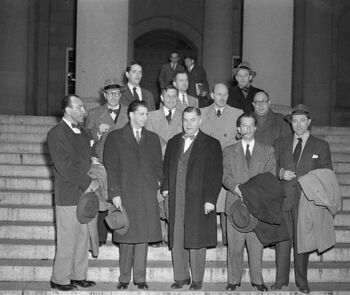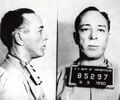Hollywood Ten (nonfiction): Difference between revisions
Jump to navigation
Jump to search

No edit summary |
|||
| (4 intermediate revisions by the same user not shown) | |||
| Line 1: | Line 1: | ||
[[File: | [[File:Hollywood_Ten_await_fingerprinting.jpg|350px|thumb|The Hollywood Ten in November 1947 waiting to be fingerprinted in the U.S. Marshal's office after being cited for contempt of Congress. Front row (from left): Herbert Biberman, attorneys Martin Popper and Robert W. Kenny, Albert Maltz, Lester Cole. Middle row: Dalton Trumbo, John Howard Lawson, Alvah Bessie, Samuel Ornitz. Back row: Ring Lardner Jr., Edward Dmytryk, Adrian Scott.]]The '''Hollywood Ten''' were a group of ten writers and directors who were cited for contempt of Congress and blacklisted after refusing to answer questions about their alleged involvement with the Communist Party. | ||
The ten individuals were: | The ten individuals were: | ||
| Line 13: | Line 13: | ||
* Adrian Scott, producer and screenwriter | * Adrian Scott, producer and screenwriter | ||
* [[Dalton Trumbo (nonfiction)|Dalton Trumbo]], screenwriter | * [[Dalton Trumbo (nonfiction)|Dalton Trumbo]], screenwriter | ||
A group of studio executives, acting under the aegis of the Motion Picture Association of America, fired the artists—the so-called Hollywood Ten—and made what has become known as the Waldorf Statement. The Hollywood Ten were systematically prevented from working in the film industry. | A group of studio executives, acting under the aegis of the Motion Picture Association of America, fired the artists—the so-called Hollywood Ten—and made what has become known as the Waldorf Statement. The Hollywood Ten were systematically prevented from working in the film industry. | ||
| Line 21: | Line 20: | ||
<gallery mode="traditional"> | <gallery mode="traditional"> | ||
File:Dalton Trumbo prison 1950.jpg|link=Dalton Trumbo (nonfiction)|[[Dalton Trumbo (nonfiction)|Dalton Trumbo]] refuses to betray friends and principles, enjoys state-sponsored meals for nearly a year. | File:Dalton Trumbo prison 1950.jpg|link=Dalton Trumbo (nonfiction)|[[Dalton Trumbo (nonfiction)|Dalton Trumbo]] refuses to betray friends and principles, enjoys state-sponsored meals for nearly a year. | ||
File:Hollywood Ten protest 1950.gif|Members of the Hollywood Ten and their families protest the impending incarceration of the Ten (1950). | |||
</gallery> | </gallery> | ||
Latest revision as of 19:36, 22 November 2016

The Hollywood Ten in November 1947 waiting to be fingerprinted in the U.S. Marshal's office after being cited for contempt of Congress. Front row (from left): Herbert Biberman, attorneys Martin Popper and Robert W. Kenny, Albert Maltz, Lester Cole. Middle row: Dalton Trumbo, John Howard Lawson, Alvah Bessie, Samuel Ornitz. Back row: Ring Lardner Jr., Edward Dmytryk, Adrian Scott.
The Hollywood Ten were a group of ten writers and directors who were cited for contempt of Congress and blacklisted after refusing to answer questions about their alleged involvement with the Communist Party.
The ten individuals were:
- Alvah Bessie, screenwriter
- Herbert Biberman, screenwriter and director
- Lester Cole, screenwriter
- Edward Dmytryk, director
- Ring Lardner Jr., screenwriter
- John Howard Lawson, screenwriter
- Albert Maltz, screenwriter
- Samuel Ornitz, screenwriter
- Adrian Scott, producer and screenwriter
- Dalton Trumbo, screenwriter
A group of studio executives, acting under the aegis of the Motion Picture Association of America, fired the artists—the so-called Hollywood Ten—and made what has become known as the Waldorf Statement. The Hollywood Ten were systematically prevented from working in the film industry.
In the News
Dalton Trumbo refuses to betray friends and principles, enjoys state-sponsored meals for nearly a year.
Fiction cross-reference
Nonfiction cross-reference
External links:
- Hollywood blacklist @ Wikipedia

